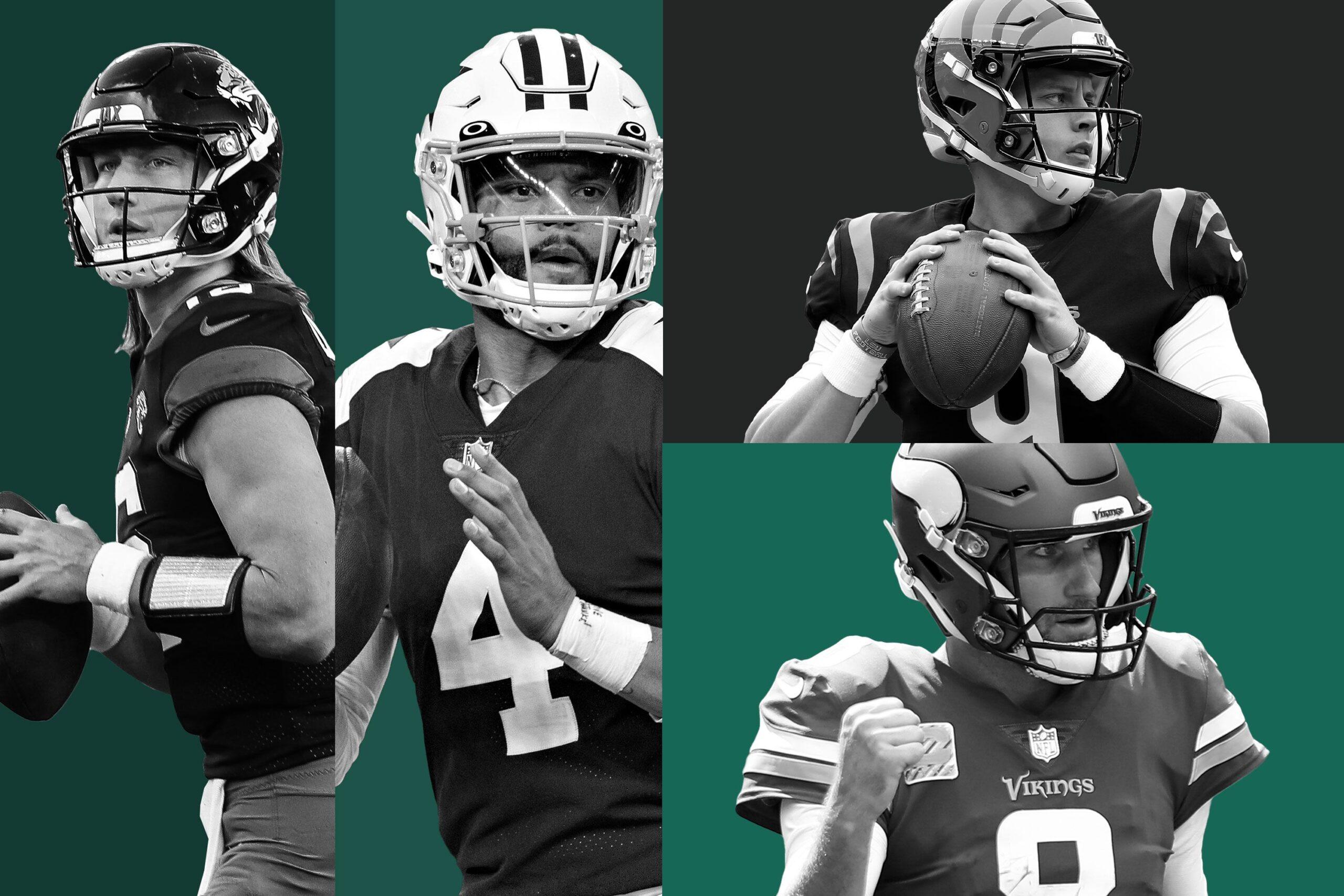
For nearly half an hour this past Monday, New York Giants general manager Joe Schoen held strong in revealing very little about his team’s near-medium future. It was two days after the Giants’ unceremonious 38-7 playoff exit at the talons of the soaring Philadelphia Eagles, and Schoen and head coach Brian Daboll were facing the media at their season-ending Q&A. There, the New York press had seemingly taken a page from the Philly pass rush: A bunch of seasoned professionals were seeking, relentlessly, to get at Giants quarterback Daniel Jones.
“Do you plan on re-signing Daniel?” was the very first question asked. “We’d like Daniel to be here,” Schoen responded, not exactly answering. Last spring, one of Schoen’s early moves as the newly hired Giants GM was to decline to pick up the quarterback’s $22.38 million fifth-year option, preferring to first see for himself how Jones might perform in his fourth NFL season. “He’s done everything that we’ve asked him to do,” Schoen said, speaking of a season in which Jones had career highs in completions, passing yards, rushing touchdowns, and quarterback rating, as well as a career low in turnovers. The Giants, despite having prioritized a rebuilding period, and in spite of one injury after another, made the playoffs and even won a round following a surprisingly merry 9-7-1 campaign. So now what to do about their soon-to-be free agent QB?
“Again, there’s a business side to it,” Schoen filibustered. “We haven’t went down that road yet.” Schoen had a similar answer to the second question in the presser, which was also about Jones, and to the fifth question, which was about Jones, too. “When you say you want Daniel back,” someone tried, “ideally, would you like that to be a long-term deal or a multiyear deal?” It was an inquiry as cleverly restructured as any NFL contract. But Schoen still wouldn’t put anything in ink. “We’re going to get into all that,” he said. “Again, it takes two. Both sides have got to have those conversations. We haven’t crossed that bridge yet. There’s tools at our disposal. Again, we’ll go through several scenarios.” On and on it went like that, one Schoen “again” after another for 28 minutes straight.
Until someone asked, “Do you view Daniel as a quarterback who can help you win a Super Bowl?” and finally found a little daylight. “We’re happy Daniel’s going to be here,” the GM mused, before kinda catching himself, having maybe said too much. “We’re happy he’s going to be here—hopefully we can get something done with his representatives,” he added quickly and with emphasis. Someone piped up eagerly from the peanut gallery, just to make sure they’d heard right: “You’re saying he’s going to be here next year?”
Even Daboll, next to Schoen on the dais, looked over with a teensy quizzical smile, as if excited to see how his colleague would wriggle out of this one. “We’re going to have these offseason meetings here at the end of the week, and we’re going to talk about it,” Schoen recovered, back on message like a champ after having let down his guard for an instant. But that’s all it ever takes.
The best New York tabloid headlines are the ones that harmonize with the daily rhythms of the city, all smirking lilts and urgent mutters and in-the-know asides that are part radical acceptance, part lyrical curse. When “THAT’S A LOT OF DIMES, DANNY” ran on the back page of the New York Daily News a week ago, in the giddy aftermath of the Giants’ wild-card win over the Vikings, it was a sentence you didn’t have to understand to get, something that rang true on any register.
It was as easy to imagine someone shouting it at a beautiful stranger across Atlantic Avenue as it was to envision the phrase instigating a woozy closing-time shoving match in Murray Hill. Hearing “THAT’S A LOT OF DIMES, DANNY” could mean you’re at a power lunch getting a promotion, or that you’re on the subway getting roasted by teens, or that you’re a WFAN caller finally getting on air. And last Wednesday, splashed across the newspaper’s sports section, those words had a mix of all of the above, conveying both wonder and envy at someone else’s somewhat unexpected potential good fortune. (That emotional mix isn’t found only in New York, but like so many things, it’s a hell of a lot louder there.)
“If it seems the price on Daniel Jones’ contract extension is going up every week,” an adjacent Daily News caption read, “that’s because it is.”
The current going rate for a top NFL quarterback beyond his entry-level deal is anywhere in the wide and lucrative range of $30, $40, or $50 million a season. Aaron Rodgers, the league’s highest-paid passer, makes just north of that; guys like the Lions’ Jared Goff or the Commanders’ Carson Wentz earned relatively average salaries of $33.5 and $32 million, respectively, in 2022.
This coming year, it is projected that putting a fully exclusive one-year “franchise tag” on a quarterback could cost a team somewhere in the neighborhood of $45 million—the number is approximate, as it’s tied to changes in the overall salary cap—and even a nonexclusive tag might run a team like the Giants upward of $32 million. (Under that option, if another team reached out to Jones with an offer sheet that New York didn’t wish to match, the Giants would be entitled to two first-round draft picks as compensation.) Ultimately, the biggest question when it comes to Jones isn’t so much about the amount a top NFL quarterback should get paid—it’s about whether Jones should even be considered one of them.
Earlier this month, in his postseason debut, Jones led the New York Giants to their first playoff victory in over a decade with a 31-24 road win over the Minnesota Vikings. It was a game in which he completed 24 of 35 passes for more than 300 yards, threw for two touchdowns with no interceptions, and constantly hurled himself forward with the ball (17 carries!). The performance was so well rounded as to be an NFL playoff first, and it felt a lot like the good old days for the team and its quarterback. Well, it felt a lot like this one specific good old day, to be clear.
Back in September 2019, Jones made his first NFL start for the Giants, a 32-31 road win in Tampa. It was a game in which he completed 23 of 36 passes for more than 300 yards, threw for two touchdowns and no interceptions, and constantly hurled himself forward with the ball. (Two additional rushing TDs!) What made both that early performance and this recent one feel so fun and satisfying is the way they nodded, however briefly, toward a new world in which Jones could be the exciting, easygoing Eli Manning 2.0—the leader of a multifaceted New York offense.
But both showings were also alike for a less fun reason: They were preceded by awkward and prolonged periods of disinterest, and even doubt, in Jones and the Giants that originated from deep inside the house.
While it was a hoot to watch Jones break out in the fall of 2019, much of that year had been pretty odd and unpleasant for the rookie. Manning’s long tenure was winding down unceremoniously, and fans took out their impending separation anxiety on poor Jones. (The kid was booed at the draft, and nowhere was safe: Once, at an ice cream parlor in his home state of North Carolina, he was subjected to a scoopster who, not recognizing Jones, made fun of the Giants for having taken him with the sixth pick. Cold!) On Jones’s first night as a Giant, the very man who drafted him, former GM Dave Gettleman, made an oddly favorable comparison, likening the Manning to Jones shift to the Packers’ Brett Favre to Aaron Rodgers transition from 2005 to 2007. When an alarmed reporter asked whether that meant Gettleman’s plan was to draft Jones at no. 6 and then sit him for three years, his existential response was not particularly soothing: “Who knows? I may go out there in my car and get hit.” Welcome to the team, Danny boy!
In his first three seasons with the Giants, Jones amassed a 12-25 starting record. Two different head coaches were sacked, and Gettleman retired. The Giants have played in front of no fans and in front of booing crowds. Jones missed six games with a neck injury and later had “a non-football-related procedure” done, also to his neck. Just about a year ago, in January of 2022, the Giants hired Schoen from the Buffalo Bills to help preside over a thoughtful rebuild. A few days after that, owner John Mara didn’t mince words about his quarterback and his team.
“We’ve done everything possible to screw this kid up since he’s been here,” Mara said. “We keep changing coaches, keep changing offensive coordinators, keep changing offensive line coaches. I take a lot of responsibility for that. Let’s bring in the right group of coaches now, give him some continuity, try to rebuild the offensive line and try to make an intelligent evaluation of whether he can be the franchise quarterback or not.” The team announced the hiring of Daboll, at the time Buffalo’s Josh Allen whisperer, three days later.
In April, the Giants opted not to pick up Jones’s fifth-year option. As The Ringer’s Steven Ruiz pointed out at the time, there was no precedent for an NFL team declining a fifth-year option and subsequently re-signing that quarterback. But then this fall the Giants won some close games, and then some others. Running back Saquon Barkley finally got past several nagging injuries and had his finest stretch as a pro, which helped make Jones’s mobility even more of an asset. Plenty of other players did have injury issues—a handful of guys suffered ACL tears alone—but the team kept carrying on. It made the postseason for the first time since 2016, and, with Jones looking like a confident NFL franchise SlimeTime quarterback, the team won its first playoff game since the 2011 season.
“Jones may bag $38M per season,” said the Daily News back page a few days later, under the “THAT’S A LOT OF DIMES, DANNY” headline, “and if he leads Giants past Eagles Saturday, forget it.”
“Forget it” was apt, as it turned out, but not for the reason the News had originally printed. Saturday’s divisional-round game came and went, and the Eagles embarrassed the Giants badly enough that the game not only dredged up old doubts from the past, but also raised new questions about the future. “RISKY ‘BUSINESS’” was the Daily News’ Monday morning back-page headline. “Nothing personal, but it’s time for Giants and Daniel to talk money, AND ANYTHING CAN HAPPEN.” The sports pages had all the volatility of a stock chart.
The team, wisely, has seemed to avoid that sort of overreaction. In the wake of the win over the Vikings, Giants co-owner Steve Tisch released a letter about the state of the team that sounded more like it had been written with the expectation of a loss. (We have a lot of work to do was the gist of it; I suppose it’s difficult to join in on the heady feeling of playing with house money when you are, in fact, the house.) When asked about Jones’s performance in the victory, Daboll and offensive coordinator Mike Kafka remained understated, calling his play “good” and a “nice job.” And on the flip side, while Daboll described the feeling of losing to the Eagles as “a crash landing,” by Monday he was back to talking frankly and dispassionately about the realities of picking up—or discarding—the pieces and moving forward. “It’s different than it was 30 years ago,” Daboll explained Monday. “Each year, you come in here in April 17 for the offseason program, and when you ask the new guys to stand up, it will be dang near half the room.”
Jones, for his part, seems relatively resigned to any manner of outcomes. “I’ve really enjoyed being here,” he said on Sunday as he cleaned out his locker. “I have nothing but love and respect for this organization. I’d love to be back. But we’ll see, and there’s a business side of it, too. So I’m very grateful to be here and be a part of it.”
It’s likely that the organization aims to view this offseason with the same refined, clear remove of both Daboll and Jones—and it will need to. Jones is far from the only player whose offseason handling looms large for the Giants; the team most notably has a big decision to make about Barkley, too, as well as nose tackle Dexter Lawrence. But given the turnover in the coaching and executive ranks—and there may be even more of that soon, with Kafka and defensive coordinator Wink Martindale being interviewed for head-coaching gigs—the decision about whether to keep Jones has a larger element of maintaining some shred of organizational consistency. And given the amount of cap space a typical quarterback contract eats up, what they choose to do with him will have ripple effects across building the rest of the team.
What’s the best way to clear enough cap space to make meaningful improvements to the lineup without losing the most-skilled players at the team’s core? How exactly do you weigh the needs of tomorrow against the egos of today? (In other words: Might Jones be affixed with the franchise tag, a decision that must be made by March 7, or could it be Barkley?) What is the going rate for players who haven’t really gone much of anywhere just yet? What would be the cost of starting again—again? These are lines of inquiry that involve the entire roster, but their answers tend to revolve around the guy who lines up under center. And when it comes to him, the most pressing question seems to be: Do the franchise and its quarterback still have more good old days ahead?
For the answer to be yes, the Giants will have to free up money or use draft picks to beef up their offensive line. (New York has amassed nine picks in the 2023 draft.) And maybe find a receiver. And they’ll need to figure out what to do with perhaps the highest-profile star on the team: On Monday, when reporters weren’t asking Schoen and Daboll about Jones, they were mostly asking about Barkley, another key free agent. For running backs, the market is differently sized than for quarterbacks: Christian McCaffrey’s $16 million average contract is tops in the cohort, and the franchise tag this year ought to fall in the realm of $10-$12 million. Barkley, in interviews, said that he wasn’t trying to reset the market, but that he would also feel slighted—“I think it would upset anybody,” he said—by the limitations of the franchise tag. As a running back with an injury history, however, he might be the sort of player with whom it would make sense—from the team’s perspective, at least—to go that route.
This fall, during their bye week, the Giants approached Barkley with an offer said to be around $12 million per year, but talks broke off. “We weren’t close,” Schoen said on Monday. He may have been talking about contract negotiations, but—as the Eagles game put on display—the New York Giants aren’t particularly close, either. “I don’t believe in the You’re one player away,” Schoen said. “I think it’s truly a team game.”
The process of building a Super Bowl contender in the NFL is like trying to make a dollar out of 15 cents. The trick is finding the balance between leveraging what you have and scrounging for what you need. You could immediately seek more change, sure—but sometimes it helps to invest around the dimes that are already in your pocket.


